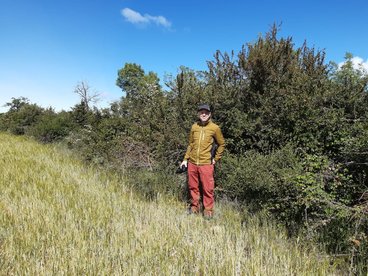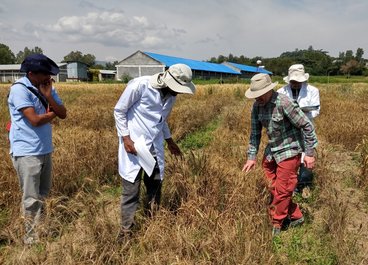Olivera visits Spain, Ethiopia for research and teaching
International collaboration is a cornerstone of the discipline of plant pathology. National boundaries are no match for plant diseases, nor are the dangers of food shortage unique to one nationality of human.
Research Associate Professor Pablo Olivera Firpo just returned from an international trip to Spain and Ethiopia that combined research collaboration, conference presentation and education for the betterment of the cereal rust research community worldwide.

Part 1: Spain
Motivated by Yue Jin’s (Cereal Disease Lab) interest in native barberries of the Mediterranean region, a strong partnership between Minnesota and the University of Lleida and the Institute of Agrifood Research and Technology (IRTA) of Catalonia was established. The main goal is to examine barberry’s role in generating new virulences in cereal rust populations. Examinations at the University of Minnesota and the Cereal Disease Lab of rust samples from Spain have found a highly virulent and dangerous rust population, and a lasting relationship has been built between Spanish and Minnesotan researchers.
Hosted by Dolors Villegas (IRTA) and Carlos Cantero-Martinez (University of Lleida), Pablo’s visit to Spain began with attendance and presentation at a conference at the University of Lleida, in the Catalonia autonomous region. Though the conference was focused on wheat physiology and breeding, Pablo’s pathology-focused poster attracted interest of breeders on the importance of improving stem rust resistance. As stem rust resurges in Spain after a period of relative dormance, Pablo called this conversation and its traction “an eye-opener” to the importance of rust resistance.
After the conference, Pablo met with Lleida students in the Masters program in Plant Protection to discuss rust biology, epidemiology, control, and global monitoring. He emphasized the value of visiting in person: “it makes so much difference to deliver the talk and have the conversation in person than to do it on Zoom.”
Finally, Pablo spent four days in the highlands of the Aragon autonomous region (near Catalonia) visiting sites where barberry plants are grown side-by-side with cereal crops. Since it was a dry year, rust was less prevalent than expected, but valuable monitoring and conversations with growers still made the experience fruitful.
The travel experience was unique as well—throughout, Pablo stayed in towns as small as thirty homes, tucked between wheat fields, which facilitated sampling, building connections with local growers and researchers, and enjoying the food, wine, and scenery of Spain.
Finally, Pablo gave his last seminar of this Spain trip, with the purpose of promoting the work done in partnership with Dolors Villegas as she transitions from a regional research center (IRTA) to a national one (CSIC) in Zaragoza, and how opportunities to exchange information, share funding, and advise students and future research leaders together could be positive future directions.
Part 2: Ethiopia

Pablo’s collaboration with Ethiopia started in 2009, and since then he has visited the country over 20 times. However, due to political unrest and COVID-19, Pablo was not able to visit and participate onsite in these meaningful collaborations since 2019. Four years later, he returned to Ethiopia to evaluate wheat germplasm for stem rust resistance and connect with new and incoming research staff. This visit was in the company of Dave Hodson and Yoseph Alemayehu from CIMMYT.
Upon arrival in Ethiopia, Pablo visited the Debre Zeit National Research Center to evaluate over 1,000 wheat and barley genotypes for stem rust resistance at the international nursery on behalf of Matt Rouse from the Cereal Disease Lab. This stem rust nursery, one of the two international nurseries (in addition to the one in Njoro, Kenya) established by the Borlaug Global Rust Initiative, provides critical support to international wheat and barley breeding programs by evaluating cultivars for resistance to Ug99 and other highly virulent races.
Following that, Pablo spent four days at the Ambo Plant Protection Center to work on collaborative training, and capacity-building with researchers at the race-typing laboratory. Due to a large amount of recent staff turnover, new scientists needed support and hands-on training on all the protocols involved in the race-typing operations. Pablo worked alongside Kitessa Gutu and Dr. Jemal Toro reviewing and adjusting operations for rust collection, long-term storage, disease scoring, supply and equipment purchasing, and other vital components of the research.
And while Pablo is back in Minnesota, now he intends to go back to Ethiopia and Kenya soon, perhaps in the fall. International collaboration, in particular with developing countries, is the strongest motivation in Pablo’s professional career and as he says, “I will never miss an opportunity to jump on a plane to learn from and work alongside international partners.”
